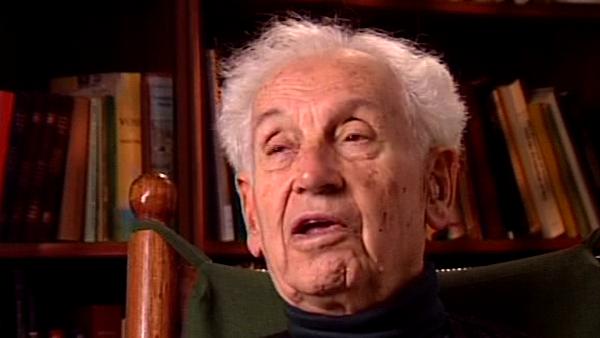NEXT STORY

The species in nature
RELATED STORIES

NEXT STORY

The species in nature
RELATED STORIES


|
Views | Duration | |
|---|---|---|---|
| 111. An attack on 'beanbag genetics' | 386 | 02:26 | |
| 112. Shortening the book | 119 | 01:19 | |
| 113. The importance of gene flow | 191 | 02:15 | |
| 114. The species in nature | 182 | 01:21 | |
| 115. Sympatric speciation | 206 | 01:42 | |
| 116. Two levels of evolution | 333 | 02:34 | |
| 117. Natural selection | 343 | 04:11 | |
| 118. My interests outside of science | 249 | 02:39 | |
| 119. The evolution of ideas | 228 | 02:24 | |
| 120. Thomas Kuhn's theory of scientific revolutions | 635 | 02:24 |


The uniformity of species I had ascribed entirely due to gene flow. And I was very much attacked by Ehrlich and a co-author, Holm I guess it was, saying there… there was very little gene flow. Well, he has been… he was working with a butterfly that lives in isolated colonies at high altitudes in the Rocky Mountains and, indeed, that particular species doesn't have very much gene flow. But… so there was no need for me to reduce the emphasis in gene flow as much as I had done in this 1970 volume. More recent work has come out by various authors which show that in a majority of species there is indeed a great deal of gene flow and they have confirmed something that I had mentioned in my ’63 volume and I think even earlier, that there is a… a certain amount of so-called polymorphism for dispersal facility. In every population, I claimed certain individuals have a tendency to stay right where they are, they are totally philopatric, as the term is that I had coined. Another percentage of individuals, perhaps the majority scatter a certain amount between birth and the time they reproduce, but not very far. And then there is a small minority of individuals who go far away, hundreds of miles and settle down there. I first found this in banding results of German birds, but it has now been confirmed by Drosophila and… and other organisms. So, gene flow indeed occurs a great deal. On the other hand, I introduced in my 1970 edition another explanation for the uniformity of species and that is that, simply, that the genotype that, as I had always emphasized, has a certain cohesion, also, therefore has certain conservative aspects. It is very difficult to change a genotype very drastically even by geographic variation.
The late German-American biologist Ernst Mayr (1904-2005) was a leading light in the field of evolutionary biology, gaining a PhD at the age of 21. He was also a tropical explorer and ornithologist who undertook an expedition to New Guinea and collected several thousand bird skins. In 1931 he accepted a curatorial position at the American Museum of Natural History. During his time at the museum, aged 37, he published his seminal work 'Systematics and Origin of the Species' which integrated the theories of Darwin and Mendel and is considered one of his greatest works.
Title: The importance of gene flow
Listeners: Walter J. Bock
Walter J. Bock is Professor of Evolutionary Biology at Columbia University. He received his B.Sc. from Cornell and his M.A. and Ph.D. from Harvard. His research lies in the areas of organismal and evolutionary biology, with a special emphasis on functional and evolutionary morphology of the skeleto-muscular system, specifically the feeding apparatus of birds.
Tags: Rocky Mountains, 1970, 1963, Paul R Ehrlich, Richard W Holm
Duration: 2 minutes, 16 seconds
Date story recorded: October 1997
Date story went live: 24 January 2008